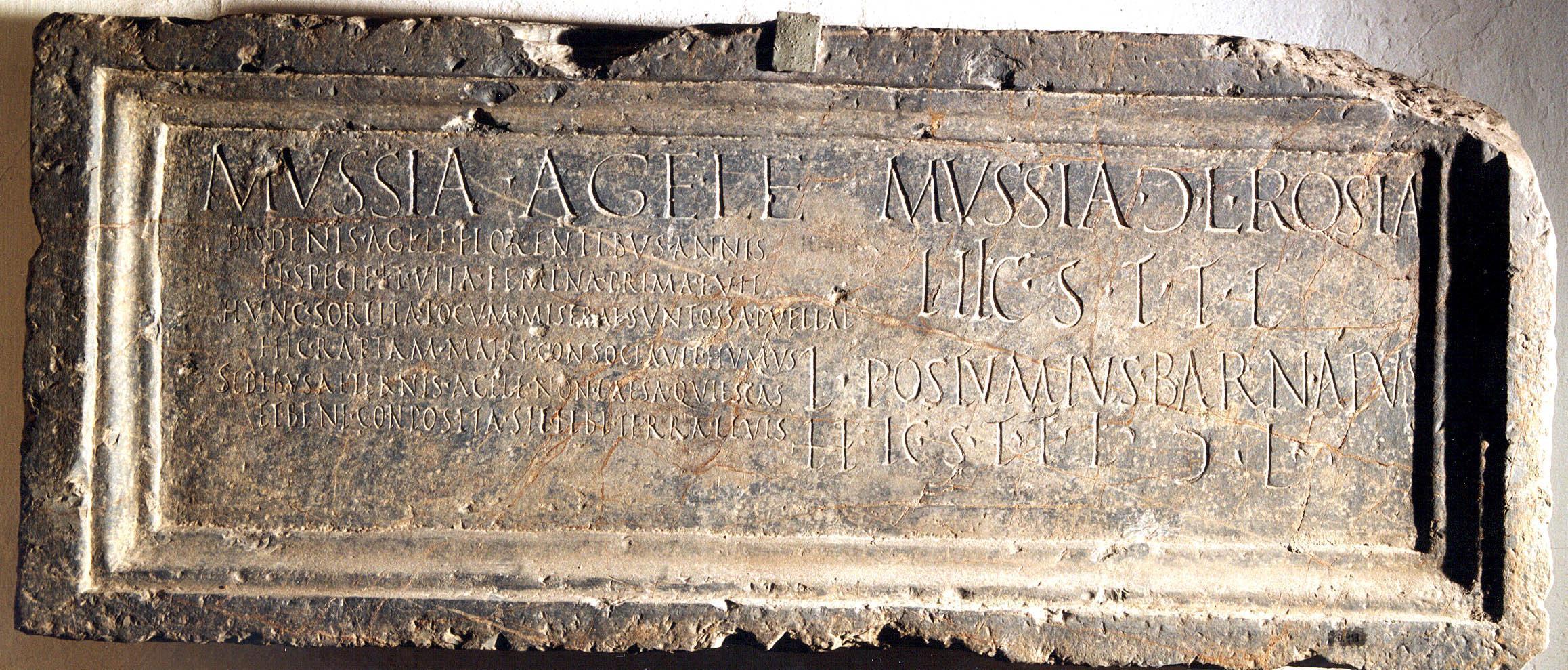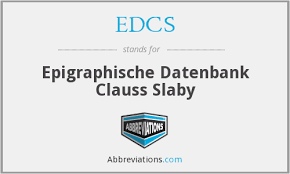Epitaph of Musia Ágele, Musia Rosia and L. Postumio Barneo
Reference CIL II2/7,498 | Description | Lyrics | Location | Chronology | Epigraphic edition | Translation | Apparatus | Comentary | Type of verse | Text divided into verses and metric signs | Images | Bibliography | Link to DB | Author |
Epitaph of Musia Ágele, Musia Rosia and L. Postumio Barneo
Description
- Idno filename 22/01/0058
- Type of inscription: Sepulcralis
- Material Description: Rectangular tablet of very dark grey limestone with whitish veins.
- Dimensions height/width/depth (cm): 43/105/16
-
Epigraphic field:
- Layout: The epigraphical field (27.5 x 87.5) is framed in a double moulding, lowered and divided into two almost identical zones. The carmen (text a) is on the left; prose epitaphs (b and c) of two other people are on the right. The even lines, pentameters, are indented. Triangular interpunction signs at the end of lines, except at the verse boundaries.
- Epigraphic field dimensions hieght/weight (cm): 27.5/87.5
- Preserved
Lyrics
- Font:Libraria
- Letter size:4,5 y 5 cm
- Description of the letters:Letter carefully executed in a.1 and b.1 Letters of 4,5 in a.1 and b.1, 1-2 in the rest; I "longa" in a. 5.
Location
- Place of discovery: Found before 1948 in Córdoba, in the “Huerta Cebollera”, Avenida de Medina Azahara.
- Geolocation
- Conservation location: Conserved in the columbarium of the M.A.P. in Córdoba.
- Inventory number: 10413
- Location with Modern Nomenclature España / Córdoba
- Location with Old Nomenclature Hispania / Baetica / Cordubensis / Corduba
Chronology
- Inscription's dating: Between year 30 and year 70
- Dating explanation: Middle of the 1st c., from the type pf lettering and the use of the sign Ɔ to indicate the status of liberto.
Type of verse
- Type of verse: Dactílico (dístico elegíaco)
- Verse/line correspondence: Si
- Prose/verse distinction: Si
Epigraphic edition
Mussia ▴ Agele
bis ▴ denis ▴ Agele ▴ florentibus ▴ annis
et ▴ specie ▴ et ▴ vita ▴ femina ▴ prima ▴ fuit
hunc ▴ sortita ▴ locum ▴ miserae ▴ sunt ▴ ossa ▴puellae
5 hic ▴ raptam ▴ matri ▴ consociavit ▴ humus
sedibus ▴ aeternis ▴ Agele ▴ non ▴ laesa ▴ quiescas
et ▴ bene ▴ conposita (!) ▴ sit ▴ tibi ▴ terra ▴ levis
Mussia ▴Ɔ (= Gaiae)▴ l(iberta)▴ Rosia
hic ▴ s(it) ▴ t(ibi) ▴ t(erra) ▴ l(evis)
10 L ▴ Postumius ▴ Barnaeus
hic ▴ s(it) ▴ t(ibi) ▴ t(erra) ▴ l(evis)▴ Ɔ (= Gaiae)▴ l (ibertus)▴
Text divided into verses and metric signs
<Mussia> bis denis Agele florentibus annis lkk|l/l|l/kk|l/l|lkk|l~
et specie et vita femina prima fuit. lkk|ll|l||lkk|lkk|~
hunc sortita locum miserae sunt ossa puellae: ll|lkk|l/kk|l/l|lkk|l~
hic raptam matri consociavit humus. ll|ll|l||lkk|lkk|~
5 sedibus aeternis, Agele, non laesa quiescas, lkk|ll|l/kk|l/l|lkk|l~
et, bene conposita, sit tibi terra levis. lkk|lkk|k||lkk|lkk|~
Translation
a) “Mussia Agele. Agele, twice ten years in flower, was the foremost woman in beauty and in her ways. This place is the lot that fell to the bones of the poor girl: here the earth has joined the seized daughter with her mother. May you rest, Agele, unharmed in this eternal dwelling. May the well-placed earth rest lightly on you”. b) “Mussia Rosia, woman’s liberta. Here. May the earth rest lightly on you”. c) “L. Postumius Barnaeus, woman’s libertus. Here. May the earth rest lightly on you”.
Bibliography
Santos Gener 1950b, 55–56 et 1952, 222 adn. 353 [index HAE 1–3 [1950–1952] n. 274]; Mariner 1955/56, 28–33 n. 11 cum im. phot. et 1960, 319–321 (inde Zarker 1958, 92; Vives, ILER 5789 et 6239 cum im. phot. ex Mariner 883); Francia 1988, 11–24; Stylow 1995, 222–223, cum im. phot. in 230; id., II2/7, 498, cum im. phot.: tab. 17 imag. 3; Fernández Martínez – Carande, CLEB CO6, cum im. phot, quae in linguam Hispanicam verterunt; Cugusi 2007, 174; id. 2010, 347; id., 2012, 21.
Comentary
Text a) is an epitaph in elegiac distichs to the young Mussia Agele, who died at twenty; in a.7,
breuis in longo before the diaeresis of the pentameter (cf. LUQUE 1994, 46). In b), an epitaph to Mussia Rosia, her mother, and in c) one to Lucius Postumius Barnaeus, probably the husband of Rosia, although not the father of Mussia, given that mother and daughter share the same nomen gentilicium. This appears to be the joint burial site of a family of liberti. The Greek name Agele is found in Italy, Hispania and Narbonensis (cf. LÖRINCZ 1994, s.v. Agele); Mussia (cf. LÖRINCZ 2000, s.v. Mussius) is documented in Italy and Hispania. The cognomen Rosia (actually a nomen) appears in another inscription from Hispania (cf. AE 1987, 525). Postumius is very popular in Hispania (cf. LÖRINCZ 2000, s. v. Postumius); Barnaeus less so (cf. LÖRINCZ 1994, s. v. Barnaeus). The repetition of Mussia has to be assumed at the beginning of a.1 in order to complete the first hexameter, and the age is described using multiplicatives. L. 2 contains the traditional elogium for a young woman; l. 3 contrasts the
youthfulness of the girl with the grim place she now occupies (a parallel from Baetica in HERNÁNDEZ PÉREZ -GÓMEZ FONT 2002). Texts a) and b) were probably cut by the same hand when the young Agele died, so that the tombstone would be a joint memorial to mother and daughter: the perfect consociauit in a.5 seems to refer to the final encounter of both in their eternal dwelling.
Author
- Author:R. Carande Herrero, C. Fernández Martínez
- Last Update2024-01-31 16:43:20
- Autopsy date:2001
You can download this






